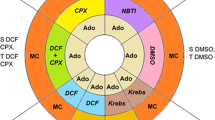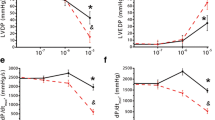Summary
In anaesthetized rabbits, the i.v. application of 1% adenosine (Ado) for 3 hours at a rate of 4 ml·h−1·kg−1 body weight increased the myocardial tissue levels of adenine nucleotides (AN) above the normal values by 39%. This increase in ATP and the sum of AN is a metabolic effect of the continuous and high supply of Ado and does not result from the Ado-induced systemic hypotension: Neither a comparable hypotension and reduction of circulatory work induced by phentolamine nor a massive volume loading caused changes in the AN. The compensation of the Ado-induced hypotension by a simultaneous i.v. application of caffeine or xylometazoline did not interfere with the accumulation of AN. The increase in AN was less pronounced, if norepinephrine was infused to maintain normotension. The increase in AN occurred in left and right ventricular myocardium to a similar extent, although the pressure-volume-work of the left ventricle decreased, and that of the right ventricle increased during Ado-application.
Similar content being viewed by others
References
Afonso S, O'Brien GS (1970) Inhibition of cardiovascular, metabolic and hemodynamic effects of adenosine by aminophylline. Amer J Physiol 219:1672–1674
Atkinson DE (1968) The energy charge of the adenylate pool as a regulatory parameter. Interaction with feedback modifiers. Biochemistry 7:4030–4034
Bache RJ, Cobb FR, Greenfield JC (1973) Effects of increased myocardial oxygen consumption on coronary reactive hyperemia in the awake dog. Circulation Research 33:588–596
Berne RM (1963) Cardiac nucleotides in hypoxia: possible role in regulation of coronary blood flow. Amer J Physiol 204:317–322
Berne RM, Foley DH, Watkinson WP, Miller WL, Winn HR, Rubio R (1979) Role of adenosine as a mediator of metabolic vasodilation in the heart and brain: a brief overview and update. In: Baer HP, Drummond GI (eds) Physiological and regulatory functions of adenosine and adenine nucleotides. Raven Press, New York, 117–126
Drury AN, Szent-Györgyi A (1929) The physiological activity of adenine compounds with especial reference to their action upon the mammalian heart. J Physiol (London) 68:213–237
Gerlach E, Schrader J, Nees S (1979) Sites and mode of action of adenosine in the heart. I. Coronary system. In: Baer HP, Drummond GI (eds) Physiological and regulatory functions of adenosine and adenine nucleotides. Raven Press, New York, 127–136
Gordon DB (1961) Basis of the depressor action of adenosine phosphate. Amer J Physiol 201:1126–1130
Gross GJ, Waltier DC, Hardman HF (1976) Effect of adenosine on myocardial oxygen balance. J Pharmacology and Experimental Therapeutics 196:445–454
Hirche HJ (1966) Die Wirkung von Isoproterenol, Adrenalin, Noradrenalin und Adenosin auf die Durchblutung und den O2-Verbrauch des Herzmuskels vor und nach der Blockierung der β-Rezeptoren. Pflügers Arch ges Physiol 288:162–185
Hochrein H, Döring HJ (1960) Die energiereichen Phosphate des Myokards bei Variation der Belastungsbedingungen. Versuche am Herz-Lungen-Präparat des Meerschweinchens. Pflügers Arch ges Physiol 271:548–563
Hopkins SV, Goldie RG (1971) A species difference in the uptake of adenosine by heart. Biochemical Pharmacology 20:3359–3365
Isselhard W (1967) Maßnahmen zur Verbesserung der Erholung des Herzens nach Anaerobiose. Langenbecks Arch Klin Chir 319:665–672
Isselhard W (1968) Effect of prenylamine on the metabolic state in various organs and on cardiac function. Biochimica Applicata 14:Suppl 1:345–365
Isselhard W (1968) Metabolism and function of the heart during acute asphyxia and in postasphyxial recovery. Aspects of resuscitation. Acta anaesth Scandinav Suppl XXIX:203–216
Isselhard W, Berger M, Denecke H, Witte J, Fischer JH, Molzberger H (1972) Metabolism of canine kidneys in anaerobic ischemia and in aerobic ischemia by persufflation with gaseous oxygen. Pflügers Archiv European Journal of Physiology 337:87–106
Isselhard W, Eitenmüller J, Mäurer W, DeVreese A, Reineke H, Czerniak A, Sturz J, Herb HG (1980) Increase in myocardial adenine nucleotides induced by adenosine. Dosage, mode of application and duration, species differences. Journal of Molecular and Cellular Cardiology 12:619–634
Isselhard W, Eitenmüller J, Mäurer W, Welter H, Reineke H (1978) Myocardial adenine nucleotides after infusion of adenosine. In: Kobayashi T, Sano T, Dhalla NS (eds) Recent advances studies on cardiac metabolism. University Park Press, Baltimore
Isselhard W, Hinzen D, Geppert E, Mäurer W (1970) Beeinflussung des post-asphyktischen Wiederaufbaus der Adeninnucleotide im Kaninchenherzen in vivo durch Substratangebot. Pflügers Archiv 320:195–209
Isselhard W, Lauterjung KL, Witte J, Ban T, Hübner G, Giersberg O, Heugel E, Hirt HJ (1975) Metabolic and structural recovery of left ventricular canine myocardium from regional complete ischemia. Europ Surg Res 7:136–155
Isselhard W, Lauterjung KL, Witte J, Giersberg O, Ban T, Heugel E (1972) Metabolic recovery after local complete ischemia of the left ventricular canine myocardium. International Congress Series No. 290. Proceedings of the 18th World Congress of the International College of Surgeons, Rome, Excerpta Medica, Amsterdam, pp 651–655
Isselhard W, Mäurer W, Stremmel W, Krebs J, Schmitz H, Neuhof H, Esser A (1970) Stoffwechsel des Kaninchenherzensin situ während Asphyxie und in der post-asphyktischen Erholung. Pflügers Arch 316:164–193
Isselhard W, Merguet H (1962) Metabolite des Glykolyse-Cyclus und des Adenylsäure-Phosphokreatin-Systems im schlagenden und durchbluteten Warmblüterherzen unter verschiedenen Versuchsbedingungen. Pflügers Archiv ges Physiol 276:211–235
Isselhard W, Merguet H, Palm K (1962) Bestimmung des Gesamtglykogens neben säurelöslichen Metaboliten in Perchlorsäure-Organhomogenaten. Z ges exp Medizin 136:174–182
Isselhard W, Pohl W, Berghoff WJW, Schmerbauch D, Schüler HW (1964) Versuche zur Verbesserung der Energiebereitstellung im künstlich stillgestellten Herzen und in der Erholung be Reperfusion. Verh Dtsch Ges Kreislaufforschung 30:216–221
Isselhard W, Reineke H, Eitenmüller J, Herb HG (1977) Erhöhung myocardialer Adeninnucleotide durch Adenosin (Adn). Langenbecks Arch Chir Suppl Chir pp 17–20
Isselhard W, Schorn B, Uekermann U (1978) Recovery of left ventricular myocardial metabolic status after varying degrees of inadequate local blood flow. Europ Surg Res 10:Suppl I, 120–121
Jacob MJ, Berne RM (1960) Metabolism of purine derivates by the isolated cat heart. Amer J Physiol 198:322–326
Jesmok GJ, Gross GJ, Hardman HF (1978) The effect of adenosine on myocardial metabolism and oxygen consumption in the isolated dog heart preparation. J Molecular and Cellular Cardiology 10:249–261
Kübler W (1969) Tierexperimentelle Untersuchung zum Myokardstoffwechsel im Angin-pectoris-Anfall und beim Herzinfarkt. Bibliotheca Cardiologica No. 22
Lammerant J, Becsei I, Mertens-Stritjthagen J, DeSchryver C (1970) Changes in the calculate myocardial oxygen consumption during adenosine infusion versus estimates of developed tension and velocity of contraction. Archives Internationales de Pharmacodynamie et de Thérapic 186:166–178
Levett JM, Repogle RL (1979) Thermodilution cardiac output: A critical analysis and review of the literature. J Surg Res 27:392–404
Lochner W, Arnold G, Müller-Ruchholtz ER (1968) Metabolism of the artificially arrested heart and of the gas-perfused heart. Amer J Cardiol 22:299–311
Mauser M, Hoffmeister HM, Nienaber CH, Schaper W (1982) Acceleration of postischemic adenine nucleotide synthesis during 3h of perfusion in the dog. Comparison of adenosine, AICAR (5-amino-4-imidazole-carboxamide-Ribose) and ribose. Pflügers Arch 394:R13
Namm DH (1973) Myocardial nucleotide synthesis from purine bases and nucleosides. Circulation Res 33:686–695
Raberger G (1979) Cardiovascular and metabolic actions of adenosine and adenosine analogs. In: Baer HP, Drummond GI (eds) Physiological and regulatory functions of adenosine and adenine nucleotides. Raven Press, New York, 155–166
Raberger G, Kraupp O, Stuhlinger W, Nell G, Chirikdjian JJ (1970) The effects of an intracoronary infusion of adenosine on cardiac performance, blood supply and on myocardial metabolism in dogs. Pflügers Arch ges Physiol 317:20–34
Rowe GG, Afonso S, Gurtner HP, Chelins CJ, Lowe WC, Castillo O, Crumpton CW (1962) The systemic and coronary hemodynamic effects of adenosine triphosphate and adenosine. Amer Heart Journal 64:228–234
Rubio R, Belardinelli L, Thompson CI, Berne RM (1979) Cardiac adenosine electrophysiologica effects, possible significance in cell function, and mechanisms controlling its release. In Baer HP, Drummond GI (eds) Physiological and regulatory functions of adenosine and adenine nucleotides. Raven Press New York, 167–182
Schorn B, Uekermann U, Isselhard W (1978) Stoffwechselstatuts des akut infarzierten Myokards in Abhängigkeit von der Restdurchblutung ohne und mit Revaskularisation. Langenbecks Arch Chir Suppl Chir Forum pp 113–117
Schrader J (1977) Sites of action and production of adenosine in the heart. In: Burnstock G (ed) Purinergic receptors (Receptors and recognition, series B, volume 12); Chapman and Hall, 11 New Fetter Lane, London, EC4P 4 EE pp 121–162
Schrader J, Baumann G, Gerlach E (1977) Adenosine as inhibitor of myocardial effects of catecholamines. Pflügers Archiv European J Physiology 372:29–35
Schrader J, Gerlach E, Baumann G (1979) Sites and mode of action of adenosine in the heart. II Ventricular myocardium. In: Baer HP, Drummond GJ (eds) Physiological and regulatory functions of adenosine and adenine nucleotides. Raven Press New York, pp 137–144
Swain JL, Sabina RL, McHale PA, Greenfield JC Jr, Holmes EW (1982) Prolonged myocardial nucleotide depletion after brief ischemia in the open-chest dog. Amer J Physiol 242:(Heart Circ Physiol 1) H818-H826
Ulmer HE (1970) Grundlagen der Thermodilutionsmethode zur Fluß-und Volumenbestimmung. Z Praktische Anästhesiologie und Wiederbelebung 5:77–90
Verdetti J, Anesedat J, Rossi A (1980) Effects de l'administration in vivo de divers précurseurs sur les reneurs en nucléotides adényliques et uridyliques du cœur de rat. J Physiol (Paris) 76:693–698
Weisel M, Brugger G, Raberger G, Kraupp O (1974) The effects of adenosine on coronary conductance, cardiac dynamics and myocardial metabolism of the isolated perfused cat heart. Pharmacology (Basel) 12:120–128
Wollenberger A, Ristau O, Schoffa G (1960) Eine einfache Technik der extrem schnellen Abkühlung größerer Gewebestücke. Pflügers Archiv ges Physiol 270:399–412
Zimmer HG (1980) Restitution of myocardial adenine nucleotides: Acceleration by administration of ribose. J Physiol (Paris) 76:769–775
Zimmer HG, Gerlach E (1974) Effect of beta-adrenergic stimulation on myocardial adenine nucleotide metabolism. Circulation Res 35:536–543
Zimmer HG, Gerlach E (1978) Stimulation of myocardial adenine nucleotide biosynthesis by pentoses and pentitols. Pflügers Arch 376:223–227
Author information
Authors and Affiliations
Additional information
This work was supported by the Deutsche Forschungsgemeinschaft, Sonderforschungsbereich 68 “Kardiovaskuläre Restitution und Organsubstitution”
Rights and permissions
About this article
Cite this article
Isselhard, W., Hamaji, M., Mäurer, W. et al. Adenosine-induced increase in myocardial adenine nucleotides without adenosine-induced systemic hypotension. Basic Res Cardiol 80, 47–57 (1985). https://doi.org/10.1007/BF01906743
Received:
Issue Date:
DOI: https://doi.org/10.1007/BF01906743




